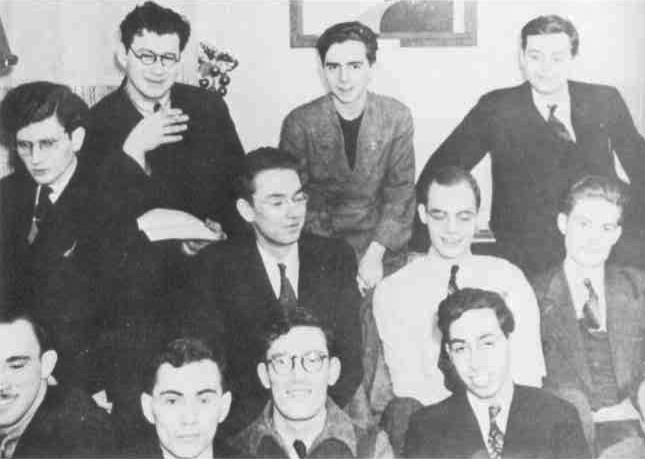I walked out of the house this morning and into the delicious crispness of the first day of fall (ignore what the calendar says; I say it’s summer when I want iced coffee and fall when I want my coffee hot — and I wanted my coffee hot this morning). Fall is books season! And, for a science fiction fan, how better to kick off books season than to dive into decades of fun hoo-hah over SF movements and literary manifestos?
I love to classify things. It’s fun! One of my earliest pleasures was to pour through tomes on dinosaurs and separate out the carnivores from the herbivores, the sauropods from the theropods, etc. Some of the biggest attractants for me to books on naval history and naval architecture were the fine distinctions between protected cruisers, belted cruisers, scout cruisers, armored cruisers, light cruisers, heavy cruisers, and battlecruisers (not to mention submarine cruisers and dynamite cruisers, those endearing oddities).
Lots of SF fans share my mania for classification and taxonomy. And since most professional SF writers have gotten their starts as fans (at least since the days of the Futurians), science fiction has been a fertile playground for those practitioners and armchair theorists who wished to divide between this and that (and oftentimes between us and them, which is when things get really juicy). Sometimes, science fiction movements have been primarily attempts by publishers to goose the market by publicizing “the new hot thing.” But far more often, movements and manifestos have erupted from the passions of fans and writers themselves, flourished or fizzled in the hothouse world of magazine letter columns, fanzines, prozines, scholarly journals, blogs, and convention discussion panels, then mellowed later into tasty subjects for historians and obsessives of the field.
The first genuine movement to have arisen from science fiction (or from science fiction fandom, to be more exact) was that of the Futurians. Much of what we think of as modern science fiction would either not exist or would be radically different had it not been for literary lives of the young men and women who numbered themselves among the Futurians’ ranks in the late 1930s and early 1940s, including Frederik Pohl, Judith Merril, Cyril Kornbluth, James Blish, and Isaac Asimov. For a bit of entertaining deep background on the roots of SF fandom, check out this excerpt (entries beginning with the letter F) from the Fancyclopedia; make special note of articles on Numerical Fandoms, Feuds, and the Futurians. Here’s an article on Fred Pohl’s involvement with the Futurians, and the man himself has written a great deal on those fabulous days of yesteryear, both in his memoir The Way the Future Was and his highly entertaining blog, The Way the Future Blogs (both highly recommended!). Andrew Milner and Robert Savage wrote about the Futurians as the vanguard of utopianism in 1930s SF, and Paul Malmont has blogged movingly on the Futurians and the joys of being involved in the wars and controversies of fandom. Bruce Sterling, lead theorist and popularizer of a more recent movement in science fiction, has claimed the Futurians as direct ancestors of the cyberpunks and lists the infamous 1939 raid by the Secret Service of a communal apartment occupied by the Futurians as part of his Chronology of the Hacker Crackdown.
One of the Futurians, Judith Merril, played a key role in the next major movement to arise from science fiction, the New Wave of the 1960s, a literary and cultural reaction against the vision of science fiction embodied by Astounding/Analog editor John W. Campbell (whose influence on the field was so monumental, he might be considered a one-man movement all on his lonesome). Other leading figures of the New Wave included Michael Moorcock, editor of the key and highly influential British magazine New Worlds; J. G. Ballard, author of classic explorations of “inner space” The Drowned World, The Drought, The Crystal World, and The Atrocity Exhibition; and Harlan Ellison, outspoken editor of landmark anthologies Dangerous Visions and Again, Dangerous Visions. Plenty of polemics and manifestos were published by the movement’s supporters (and detractors); unfortunately, since these were written in the pre-Internet age, much of this material must be hunted down in analog form (here is a helpful bibliography of key documents from the period, including essays by Judith Merril and Harlan Ellison, as well as a listing of essential works of fiction from the period). Here’s a recap of a recent reunion of a number of New Wave luminaries, a July, 2011 event at the British Library featuring Brian Aldiss, John Clute, Michael Moorcock, and Norman Spinrad.
Following all the tumult promulgated by the rolling in (and receding) of the New Wave, science fiction entered a backwards-looking phase in the latter half of the 1970s, dominated by the triumph of Star Wars (an homage to the Edmund Hamilton and Leigh Brackett space operas of the 1930s) and, on the publishing side, by Betty Ballantine’s decision to commission big, fat fantasy novels written in the Tolkien tradition. However, the conservative reaction did not reign unopposed for long. A fresh movement, representing a whole new attitude, outlook, and aesthetic sensibility, burst on the scene in 1984 with the publication of William Gibson’s Neuromancer. Two years later, the young cyberpunk movement found its chief polemicist in Bruce Sterling, who threw down a gauntlet to the rest of the SF field in his Introduction to the cyberpunk anthology Mirrorshades. Here Bruce Sterling looks back at cyberpunk in the Nineties.
Cyberpunk had a good run, but even it eventually came to taste somewhat stale. By 2002, Norman Spinrad was kvetching in the pages of Asimov’s Science Fiction about a lack of recent, exciting movements in science fiction. Lawrence Person had written some notes toward a post-cyberpunk manifesto back in 1999, but not too many appeared ready to jump on that bandwagon. However, Norman need not have been so concerned. The decade of the 2000s would be replete with SF movements, great and small.
Like a many-tentacled horror from the unspeakable depths of Lovecraftian space, the New Weird slithered onto the scene, brought to you by those shambling monstrosities Jeff VanderMeer, China Mieville, and Paul DiFilippo, among other horrors from another dimension. Much excited chatter ensued, academics rushed to dictate The Higher Meaning of It All, and literary hipsters looked to glom onto it as the Happening Thing. But by the time the San Antonio Current was announcing “Something Weird This Way Comes,” inviting its readers in 2010 to “meet the 21st century’s new literary movement” (just a half decade late to the party), other critics were busy debunking the New Weird as a commercially viable publishing label. And other commentators stooped to terrible puns, a sure sign of the New Weird’s loss of prestige.
Around the same time as the New Weird’s inital fling with fame, Geoff Ryman was announcing his Mundane Manifesto to the Clarion Class of 2004, suggesting that science fiction should turn away from what he described as the impossible (FTL travel; time travel; alternate histories) to concentrate on the future of the possible. In case that poor quality scan of Ryman’s text hurts your eyes, Rudy Rucker explains matters in a more visually appealing format, and Ian Hocking expands further, providing additional helpful links. Mundane SF has its own blog. Finally, the always helpful Science Fiction Research Association has its say.
The tenets of the New Wave never really died; they just acquired a jazzier title: Slipstream. Proving yet again that he is one of the field’s indispensable polemicists, our old friend Bruce Sterling wrote the seminal essay on Slipstream fiction in 1989. Matthew Cheney celebrated Slipstream as the slayer of science fiction, gleefully dancing on SF’s grave in 2005. All the cool kids seemed to be going for it, but a few expressed doubts about Slipstream being a meaningful category at all. Recently, Lev Grossman decided he doesn’t like the term, politely requesting, “Can’t we rename this nerdy literary movement?”
One movement of the 2000s that has proven to be both a magnificently fertile font of discussion AND a commercially viable subcategory is Steampunk, which has spread from the literary SF world to the allied realms of filmmaking, visual arts, costuming, and role play. It, too, has had its manifesto. In fact, multiple manifestos.
Website SF Signal hosted a “Mind Meld” in September, 2010, asking a panel of experts, “What’s The Next Big Trend/Movement in SF/F Literature?” In addition to their suggestions, we may wish to mull the following contenders in the always inventive realm of SF manifestos and would-be movements:
the Ribofunk Manifesto;
the Positive Science Fiction Manifesto (this one has already generated an anthology);
the Scifaiku Manifesto;
the RocketPunk Manifesto;
the SquidPunk Manifesto;
the New Comprehensible Movement;
and, lest we forget, the New Space Princess Movement.
By the way, I recently made my own suggestion.
Then there’s Cory Doctorow’s thing. Information should be free? The anti-copyright movement has repercussions far outside the field of science fiction, but it can be said to have SF roots. Movement theorist Doctorow explains himself in 29 absolutely free, non-DRM-shackled chapters.
While we’re waiting for the Next Big Thing to emerge, here are some anthologies to enjoy regarding various Former Big Things:
England Swings SF edited by Judith Merril (out of print, unfortunately, but well worth searching for)
The New Worlds Anthology edited by Michael Moorcock
Dangerous Visions edited by Harlan Ellison
Mirrorshades: the Cyberpunk Anthology edited by Greg Bear
Rewired: the Post-Cyberpunk Anthology edited by James Patrick Kelly and John Kessel
Feeling Very Strange: the Slipstream Anthology edited by James Patrick Kelly and John Kessel
The New Weird edited by Ann VanderMeer
Steampunk edited by Ann and Jeff VanderMeer
Shine: an Anthology of Optimistic Science Fiction edited by Jetse de Vries












